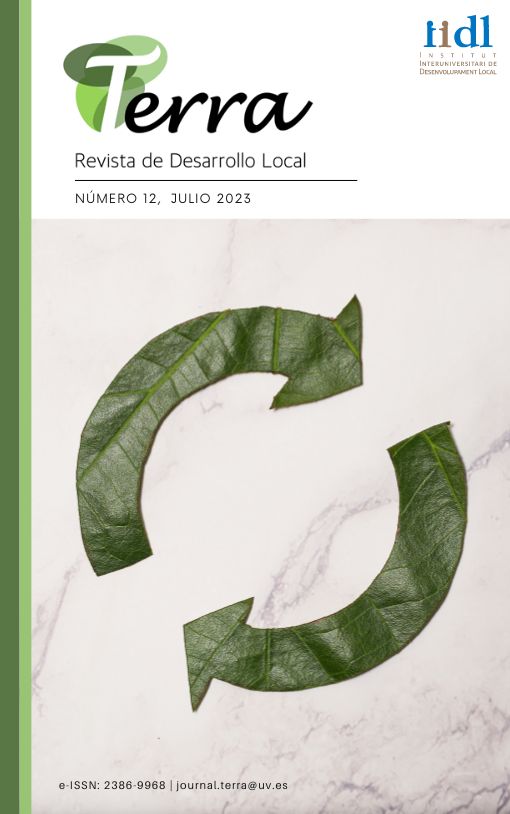Trends in Social Progress Indicators in Ciudad Juárez 2010-2020
DOI:
https://doi.org/10.7203/terra.12.26590Keywords:
Indicators of social progress, quality of life, development of the population Abstract
Abstract
In the present research, an analysis of the trends of the indicators of Social Progress in Ciudad Juarez is carried out. Social Progress in Ciudad Juarez, generally these indicators are calculated to measure the progress of countries, according to the methodology of (Porter et al., 2017), it shows the progress that has been made in the 12 components and more than 50 indicators that talk about the human needs satisfied, such as the safety of the environment, access to water, sanitation, electricity and health, in addition to access to education up to secondary level and the internet by connecting through a phone or computer, measuring the literacy rate and the quality of green spaces and care for them, as well as life expectancy and diseases such as diabetes, electoral participation, teenage pregnancy and perceptions of corruption, opportunity to enter university and discrimination. A longitudinal analysis is made using data from 2010, 2015 and 2020, analysing what has happened in a decade in Ciudad Juárez and which indicators are going down and which are going up and whether this helps to improve the quality of life of the people of Juárez. This is the first analysis of its kind to be developed in Ciudad Juárez.
 Downloads
Downloads
 References
References
AEJ. (2022). Encuestas Así Estamos Juárez. https://asiestamosjuarez.org/vista-indices/
Alpízar, C., Svarch, M., y González-Vega, C. (2006). El entorno y la participación de los hogares en los mercados de crédito en México. México: USAID. http://cide-osu.cide.edu/Sample%20Website/pagina%20web/3.Documentos/Afirma%20VII%20-%20Participacion%20de%20los%20Hogares.pdf
ANUIES. (2022). Anuario Educación Superior Licenciatura Ciclo 2010-2011; 2015-2016, 2020-2021. Anuarios Estadísticos de Educación Superior: http://www.anuies.mx/informacion-y-servicios/informacion-estadistica-de-educacion-superior/anuario-estadistico-de-educacion-superior
CONACYT. (2019). Padron del Programa Nacional de Posgrados de Calidad. Gobierno de Mexico: http://svrtmp.main.conacyt.mx/ConsultasPNPC/padron-pnpc.php?&prog=&ref=&inst=&sgrado=&sorient=&snivel=&sasni=&smodal=&sentidad=CHIHUAHUA&pag=1
Congreso del Estado de Chihuahua. (2020). Ley de Transporte del Estado de Chihuahua. https://www.congresochihuahua2.gob.mx/biblioteca/leyes/archivosLeyes/1526.pdf
El Diario. (16 de Noviembre de 2022). Fuera de la ley el 80% de los camiones urbanos. Artículo. Juárez, Chihuahua, México. https://diario.mx/estado/fuera-de-la-ley-el-80-de-camiones-urbanos-20221116-1993332.html
ENIGH. (2016, 2018 y 2020). Encuesta Nacional de Ingresos y Gastos de los Hogares (ENIGH). Nueva serie.
FICOSEC. (2015). Reporte de incidencia delictiva. Juárez: Ficosec. https://ficosec.org/
FICOSEC. (2020). Reporte de incidencia delictiva. Juárez: Ficosec. https://ficosec.org/
GOBIERNO DE MEXICO. (2022). Secretariado Ejecutivo del Sistema Nacional de Seguridad Pública. Datos Abiertos de Incidencia Delictiva: https://www.gob.mx/sesnsp/acciones-y-programas/datos-abiertos-de-incidencia-delictiva?state=published
Hernández-Hernández, V., y De Haro-De León, L. (2020). Geografía de la participación electoral y diferenciación socioespacial en Ciudad Juárez, Chihuahua (México). Geopolítica(s): Revista de estudios sobre espacio y poder, 145-172.
IMIP. (2018). Radriografía Socioeconómica. Juárez: IMIP.
INEE. (2020). Instituto Nacional de Evaluación Educativa. Paridad de genéro: https://inee.org/es/eie-glossary/paridad-de-genero#:~:text=Analizar%20la%20paridad%20de%20g%C3%A9nero,desarrollo%20de%20la%20primera%20infancia.
INEGI. (2010). Censo de Población y Vivineda. Aguascalientes: INEGI.
INEGI. (2015). Encuesta Intercensal. Aguascalientes.
INEGI. (2020). Censo de Población y Vivienda. Aguascalientes: INEGI.
INEGI. (2022). Subsistema de Información Demográfica y Social: https://www.inegi.org.mx/programas/natalidad/
Juárez2030. (2022). Juárez 2030: Plan para una ciudad sostenible. https://juarez2030.mx/#
Porter, M., Stern, S., y Green, M. (2017). Índice de Progreso Social. Washington: Social Progress Imperative. socialprogressimperative.org
SEP. (2022). Sistema Interactivo de Consulta de Estadística Educativa. Fuente:https://www.planeacion.sep.gob.mx/principalescifras/
Downloads
Published
How to Cite
-
Abstract364
-
PDF (Español)177
Issue
Section
License
![]()
The texts published in this journal are (unless otherwise indicated) under a Creative Commons license: Attribution-NonCommercial-NoDerivativeWorks 4.0 International.
The authors give way to TERRA. Revista de Desarrollo Local of the Interuniversity Institute for Local Development, the reproduction rights in scientific journals of the published texts. They also allow the management team to disseminate the contents of the contributions received and published. However, TERRA explicitly declares that it does not claim full or complete copyright control.
The management of TERRA is therefore committed to a strong commitment to open content policies and tries to guarantee the maximum copyright to authors, so that they can reproduce their works in other publications as long as they mention in the new text that it has been previously published on TERRA. Revista de Desarrollo Local, attaching the complete citation to it.
The texts published in this journal are (unless otherwise indicated) under a Creative Commons license: Attribution-NonCommercial-NoDerivativeWorks 4.0 International. The full license is available under Creative Commons.



